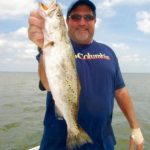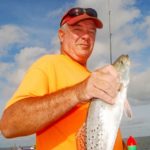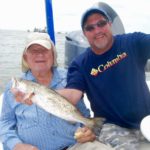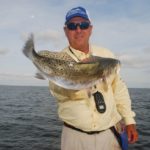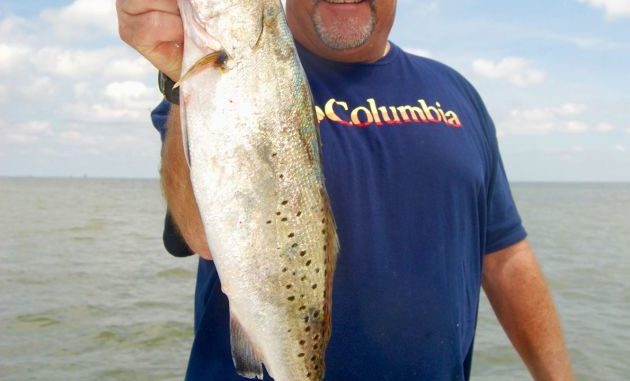
Sliding cork rig key to keep bait in strike zone above snags, guide says
They say one man’s trash is another man’s treasure.
More specifically — in the case of now-submerged Caillou Island — old oilfield trash means a treasure trove for speckled trout anglers right now out of Cocodrie.
“The island was big, maybe a quarter-mile around with a canal through it,” said Capt. Tommy Pellegrin, with Custom Charters out of Houma. “The oilfield used it as a junk pile. Pipe and other metal trash is still there, and even though the island eroded away, the iron is still there.”
After about a 35-minute ride from Harbor Light Marina early Wednesday morning in Pellegrin’s new Skeeter bay boat, Jimmy Gravois, Terry Decareaux, Whitney Poirier and I arrived at his favorite spot on the “island,” which is only recognizable now by a series of old creosote pilings visible above the waterline north of Timbalier Island.
According to Pellegrin, the key to successfully catching speckled trout there is by using a sliding cork rig with live shrimp, which allows you to easily cast the bait — and also keep it above all the junk lurking beneath the surface by adjusting the depth of your cork.
To see a video of Pellegrin at Caillou Island explaining the tactic, click here.
“It’s very difficult to fish if you go there and fish the bottom. You’re going to lose a lot of tackle,” Pellegrin said. “That’s what prompted me to start fishing the sliding cork. There’s so many fish there that you want to keep your bait off the bottom, but close to the trash where the fish are.
“So that’s the reason for the sliding rigs — so you can get in the trash and fish, but not get hung up.”
To see a detailed video of how Pellegrin assembles his sliding rig, click here.
Action was steady Wednesday morning — with at least seven other boats in the area — and we made a move to another wellhead with more than 70 solid specks on ice in less than three hours, none of which had to be measured.
Caillou Island is just one submerged island in the area that Pellegrin recommends to target for some hefty speckled trout.
“There’s a bunch of sunk islands right there. Terrebonne Island is one, Caillou Island is another,” Pellegrin said. “Get yourself an old map and look at where the land used to be and plot it on your GPS, and then search on top there.
“Some of the oyster shell reefs on the beaches of the island are still there. So if you can find the islands, and find the shells — and you’ll notice it on your electronics because of the variation on the bottom — that’s where the fish are going to be.”
Finding fish this spring hasn’t been a problem, Pellegrin said. But the weather, on the other hand, has definitely been a challenge.
“The trout bite in Cocodrie right now is phenomenal. Lake Pelto, Terrebonne Bay, Timbalier Bay, the beaches — everything has fish,” he said. “But obviously, the weather plays a big part of it. You have to find cleaner, moving water and that’s where you’re going to find the trout.
“It’s early, but the main summer patterns are intact and ready to go. We’ve already busted them on the beach, under the birds, without birds, in the bay — it’s pretty much wide open right now. It’s actually kind of hard not to go catch trout now. I won’t say you’ll catch a limit every day because of weather conditions, but on a real good weather day you’re going to bust the trout big time.”
The abundance of shrimp in the water makes the live crustacean easily the go-to bait of choice right now, he said.
“Right now, the main thing is shrimp. Shrimp season obviously just opened, but there are so many shrimp out there that’s what the trout are foraging on,” Pellegrin said. “So match the hatch — go fish with a shrimp or a shrimp imitation and catch yourself some fish.
“Away from the birds, live bait is obviously the big key. Under the birds, Berkley Rattle Shrimp would be your No. 1 bait, along with double-rigged swimming plastics. Personally, I would go more with a lighter, sparkle color because of the shrimp if they’re under birds. If you have a place where they’re over rock or trash eating minnows, then go ahead and fish a minnow pattern.”
Especially with this spring’s erratic weather, Pellegrin said he keeps a close eye on the wind forecast before making a plan of attack for his daily trips.
“If it’s a south wind, the beach will be rough so you’ll obviously fish the north side of the island because it will have cleaner water. So now you’re looking for current and reefs that have current passing on them with cleaner water and you ought to catch some fish,” he explained. “The beach trout are still there — they’re just not accessible. It’s too rough and dirty.
“But if you have a heavy north wind, the island is dirty but the beach is clean. So now go on the front side and read the sandbars on the beach to find the deeper troughs and the deeper edges, and you’ll find fish.”
Wherever he’s fishing, you can almost bet his clients will be using a sliding cork rig, which features a stopper on the main line and a heavy egg sinker to control the depth of the bait. Since the main line can pass through the cork, you don’t have 6 or 8 feet of line dangling from the end of your rod when you cast if you’re fishing a little deeper.
“I rig sliding corks because I can do anything with it. It’s just like throwing a Carolina rig on the beach, the only difference is you have a float,” he said. “You can set it to where your bait is just dragging the bottom, and you don’t have to rig and re-rig. You can leave your rod rigged like that and fish almost anything.”
